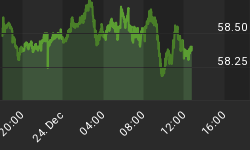As a client or neutral observer, it is fair to ask, "Given the uncertainty related to the fiscal cliff, what do you see that justifies being invested in risk assets right now?" The answer is numerous things; and the vast majority of them side with the bullish camp (as of Thursday's close).
The Charts Don't Lie
The chart below is representative of numerous weekly risk-on vs. risk-off charts used in the CCM Market Model. The graph shows the performance of stocks (SPY) relative to bonds (TLT). When the ratio (dotted line) rises, stocks are in favor relative to bonds (risk-on). When the ratio falls, bonds are in greater demand than stocks (risk-off). As you can see, as of Thursday's close, the ratio was rising (risk-on). The chart compares the June-July bottoming process in stocks to the present day. The annotations are described in more detail below the chart.

Bullish Set-Ups - Stocks vs. Bonds
-
To the right of the green dotted horizontal line, the ratio crossed above the two moving averages shown in blue and red. Follow the green dotted line up and notice how the S&P 500 performed after the ratio cleared the two moving averages (bullish for stocks). Now, look to the right and you'll see the present day market is above both moving averages (leans bullish).
-
The blue dotted line highlights a "bullish moving average crossover" (blue > red). Today, we have the same bullish cross in place (as of Thursday's close).
-
The orange dotted line shows where momentum (Wm%R) experienced a bullish centerline crossover (Wm%R > -50). We have the same bullish cross in place currently.
-
Follow the orange dotted line down to RSI; note a break above RSI 50 was followed by gains in the stock market (see top of chart). RSI closed Thursday at 52.55 or in bullish territory for stocks.
-
The bottom of the chart shows a bullish MACD cross (black>red) that occurred in late July. Gains in the stock market followed. MACD has not crossed yet, but the blue histogram is ticking up, which is designed to foreshadow a bullish MACD cross (we are close to a bullish cross).
You can make an argument that bonds are skewed due to the fiscal cliff or that one chart does not mean all that much. The counter argument is numerous intermarket relationships have similar bullish signals.
Manipulated And Confused Markets
Are there concerns? Sure, we always have concerns. The major concern is that manipulated markets are confused markets. What would bonds be worth if the Fed was not artificially suppressing interest rates? What would PE multiples and stock prices look like without low interest rates and mega amounts of printing money being pumped in the global financial system?
The confusion of market participants has created a situation where "buy signals" and "sell signals" are occurring closer and closer together as measured in days. We currently have buy signals in place, but sell signals could appear in short order. The concepts of triangles, confusion, and short-durations between bullish and bearish signals are illustrated on this chart of semiconductors vs. bonds. Many markets look confused and have similar triangles.
Maximum Flexibility Required
As noted in last week's video, the triangles and confusion of market participants mean we must be willing to abandon our bullish stance if bearish signals begin to appear. Maximum flexibility will be required to ensure we stay on the right side of the markets. As conditions change, we will try to provide updates via Twitter (@CiovaccoCapital).
















